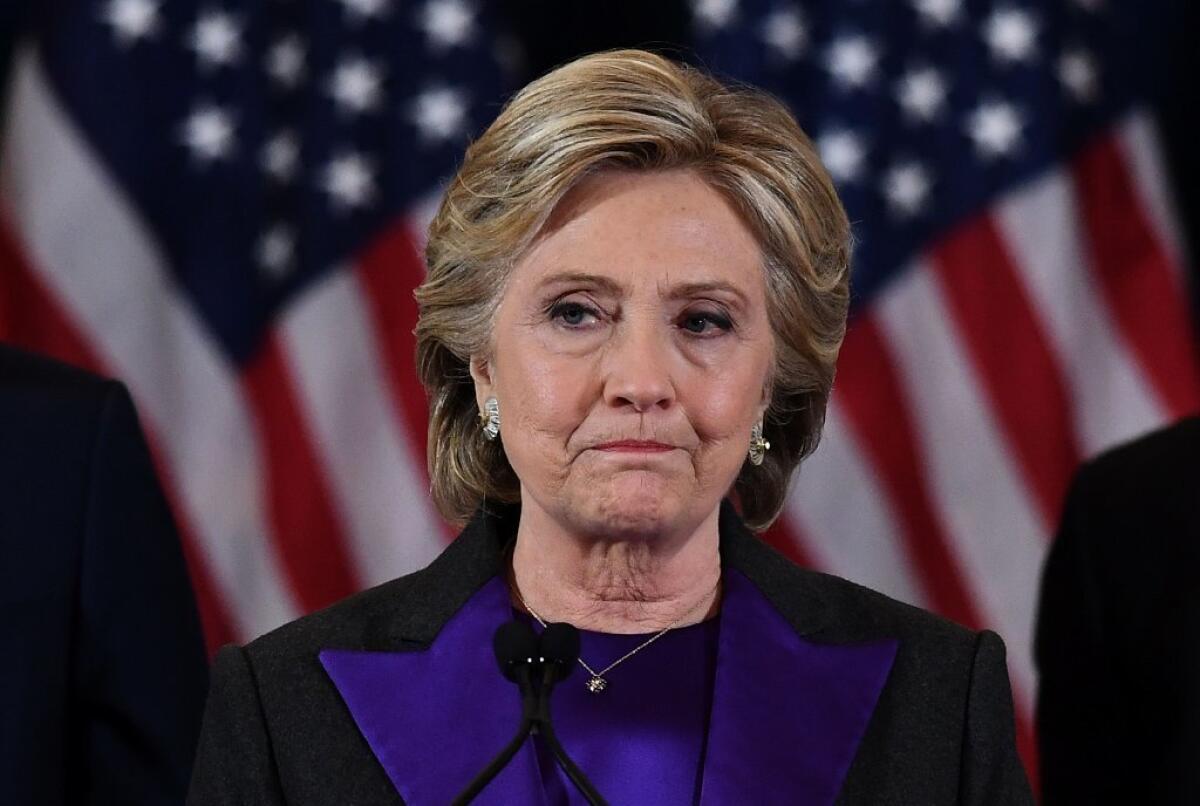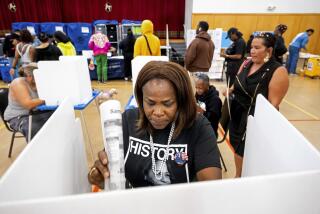Clinton won as many votes as Obama in 2012; just not in the states where she needed them most

Hillary Clinton won the popular vote by at least 2.8 million, according to a final tally. The result marked the biggest gap between the popular vote and the electoral college in almost 150 years.
- Share via
Reporting from Washington — The final results of the 2016 presidential election look like this: Hillary Clinton got roughly the same number of votes that President Obama received four years ago en route to his reelection, but she nonetheless lost the presidency to Donald Trump, who came in at least 2.8 million votes behind her.
That’s a highly unusual outcome — the biggest gap between the popular vote and the electoral college in almost a century and a half. Only now, with almost all the nation’s ballots counted, have analysts begun to flesh out what led to that result and what implications it has for the nation’s deep political divisions.
Start with California, where Clinton beat Trump by almost 2 to 1, amassing a margin of more than 4.2 million votes. That’s a victory more impressive even than Obama’s in 2012, and it included a win in Orange County, which had sided with the Republican in every presidential election back to 1936.
Note: a previous version of this chart mistakenly stated that a Democratic candidate had won the 1952 election in California. Republican candidate Dwight D. Eisenhower won the state that year with a margin of 14%.
But Clinton’s huge majority in the nation’s largest state was also part of her key weakness — a base of support too concentrated in the big, urban areas of the northeast and the West Coast.
A candidate gets all of a state’s electoral votes whether she wins by four or 4 million, so in the national picture, the huge size of Clinton’s majority in California, as well as a similarly lopsided margin in New York, did her no good. Clinton piled up similarly “wasted” votes in some big, Republican states — notably Georgia and Texas — in which she did significantly better than recent Democratic nominees, but not well enough to win any electoral votes.
By contrast, Trump’s vote “was incredibly efficient,” said Tom Bonier of TargetSmart, a Democratic data and strategy firm based in Washington. “Where he lost, he lost big. Where he won, he won by a little. There weren’t many wasted votes. He won almost all the close ones.”
Trump narrowly eked out the victories he needed in key states of nation’s industrial belt, taking Michigan by 10,704, according to final returns, Wisconsin by 22,717 and Pennsylvania by just under 45,000, according to a compilation of the latest data maintained by David Wasserman of the Cook Political Report.
The reasons that happened varied from state to state, Bonier and other analysts note. In Ohio and Wisconsin, for example, turnout fell, belying the image of an army of previously hidden Trump voters storming the polls.
In Pennsylvania, by contrast, that image may be more accurate — turnout rose significantly across the state. Similarly, in Florida, Clinton won heavily in nearly all the places that Democrats generally count on, but lost because of a huge election-day upsurge in heavily white, nonurban counties of the central part of the state, according to an analysis by Democratic strategist Steve Schale.
One big, consistent piece of the problem was that Clinton performed worse than Obama did in blue-collar, predominantly white communities outside of major cities; such as the counties that include Scranton and Erie, Pa.; Youngstown, Ohio; Green Bay, Wis.; and Daytona Beach in Florida. In many such counties, Clinton’s vote was 15 percentage points or more below what Obama received in his reelection.
“When I look at those blue-collar areas, I’m still kind of in awe” over how dramatic the change was, said Sean Trende, election analyst for the RealClearPolitics website.
Clinton actually did better than Obama in counties that have high levels of education — Orange County being a prime example — as well as suburban counties outside Philadelphia, Atlanta, Houston and several other major cities.
Indeed, the share of the white population with a college degree or higher turned out to be one of the strongest predictors of which candidate would win a particular area this year.
Trump’s weakness in those suburban counties, which in the past have often sided with Republicans, provides “a big red, flashing sign for both parties,” said Trende.
The danger for Democrats is that “if Trump can bring those suburban Republicans back into the fold” without losing his core support among blue-collar, white voters, “he could win a pretty significant victory” in the next election, Trende said.
The danger for Republicans is that if Trump fails to improve his standing in the suburbs, “there are a bunch of GOP representatives from those districts” who could suddenly be at risk.
Like the “where” of Trump’s victory, the “when” is also fairly clear: He won heavily among voters who made up their minds in the final two weeks of the campaign.
The USC Dornsife/Los Angeles Times “Daybreak” tracking poll of the election provides evidence on that score. The poll, which tracked roughly 3,200 people through the campaign, resurveyed them after the vote.
Those who had said they were certain about which way they would vote almost all followed through as predicted. But among the smaller group who were still uncertain about their vote in late October — people who said, for example, that they were only 60% likely to vote for their favored candidate, Trump did notably better than Clinton.
That finding suggests that voters who were undecided, or only weakly committed, late in the campaign broke toward Trump. Pollsters for both the Trump and Clinton campaigns say their internal data found similar results.
Clinton aides blame that late surge for Trump on FBI Director James B. Comey, saying that he heavily influenced the outcome with his disclosure, 10 days before the election, that the bureau was looking at a trove of emails that might be related to Clinton’s handling of classified data while secretary of State. Comey said days later that the newly identified emails would not change his previous conclusion that there was no evidence to warrant indicting Clinton.
Trump aides say that other factors were also at play, including the president-elect’s unexpectedly disciplined focus on his campaign message in the contest’s final two weeks. But they don’t deny that Comey’s letter played a role.
In contrast to the “where” and “when,” the “who” and “why” of Trump’s success remain more elusive. Analysts know, for example, that some people who voted for Obama four years ago turned around and voted for Trump this year. But they don’t yet have a good picture of how many did so compared with the number of Obama voters who simply stayed home.
Some of the answers won’t be known until states release their detailed voter files, showing who actually voted this year. Only a few states have done that so far.
Even before all the numbers are available, however, an intense and potentially disruptive argument has started among Democrats about which groups in their coalition were most responsible for Clinton’s defeat and what the answer means for the party’s future direction.
One big argument involves the relative importance of economics and race.
Aides to Trump say he won because voters in blue-collar communities favored his economic message. Particularly in the Midwest, he scored with his promise to bring jobs back to a region that has suffered from stagnant incomes and declining economic mobility for decades, they say.
Some Democratic analysts agree, at least in part. Democratic pollster Stanley Greenberg said Friday that a postelection poll conducted by his firm showed that Democrats and independents who had voted for Trump held many doubts and anxieties about the his character. Nonetheless, they “held their noses and voted” for him “because he offered a different economic vision,” Greenberg wrote in analyzing the poll’s findings.
Other Democrats and some academic analysts stress Trump’s ability to play on racial resentments among his core supporters.
Michael Tesler, a political scientist at UC Irvine, has spent the year studying the role of race in the campaign. In a series of articles, he has described survey data that show a strong link between measures of racial resentment and support for Trump among white voters.
Whites who scored high on questions that are designed to measure racial animosity or anxiety were more likely to favor the Republican candidate this year than they were in 2008 and 2012, when the Democratic candidate was the country’s first African American president, he found. That could be a result of some of the racially tinged language Trump used in the campaign.
Another issue involves how badly Clinton underperformed among millennial generation voters.
The Clinton campaign’s internal data indicate that the drop-off among voters younger than 30 was a key problem. Those voters mostly did not side with Trump — he remains unpopular with younger Americans — but enough either stayed home or voted for third-party candidates to make the difference in the closest states.
“We needed to be in the low 60s with young people, and at the end of the day, we were in the high 50s,” Clinton’s campaign manager, Robby Mook, said at a recent conference held by the Institute of Politics at Harvard University’s John F. Kennedy School of Government. “That’s part of why we lost.”
For more on Politics and Policy, follow me @DavidLauter
ALSO
Did Al Gore get played? Engaging with Trump brings risk for the left
All the times in U.S. history that members of the electoral college voted their own way
The Trumpification of Washington has already begun, and residents wonder how he will change the city
UPDATES:
9:05 p.m.: This article was updated to report that Hillary Clinton now leads Donald Trump in the popular vote by 2.8 million votes. An earlier version of the story reported her lead as 2.7 million votes.
This article was originally published at 3:10 p.m.
More to Read
Get the L.A. Times Politics newsletter
Deeply reported insights into legislation, politics and policy from Sacramento, Washington and beyond. In your inbox twice per week.
You may occasionally receive promotional content from the Los Angeles Times.











